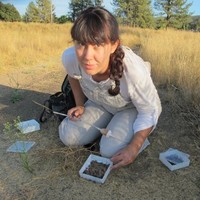
Nicola J. Plowes
- Courses1
- Reviews2
- School: Mesa Community College
- Campus:
- Department: Biology
- Email address: Join to see
- Phone: Join to see
-
Location:
1833 W Southern Ave
Mesa, AZ - 85202 - Dates at Mesa Community College: December 2016 - November 2017
- Office Hours: Join to see
Biography
Mesa Community College - Biology
Professor
Research
Nicola
Plowes
Tempe, Arizona
Dr. Plowes is an Assistant Professor at Mesa Community College where she engages students with undergraduate research projects in Behavioral and Community Ecology. She is a member of the ASU/SIRG (Social Insect Research Group), affilitated with Bert Hoelldobler and Stephen Pratt's labs.
Interests: ants, social insects, animal behavior, collective behavior, behavioral ecology, SOTL (Scholarship of Teaching and Learning), sustainability practices
Experience
University of Connecticut
Graduate Student
Studied territorial behavior in Solenopsis invicta (Red Imported Fire Ants) and Tetramorium caespitum (Pavement Ants).
Plowes & Adams (2005) An empirical test of Lanchester's square law: mortality during battles of the fire ant Solenopsis invicta. Proc. R. Soc. B 272: 1809-1814.
doi: 10.1098/rspb.2005.3162
Dissertation: http://gradworks.umi.com/33/25/3325625.htmlCourse Hero
Reviewer
Nicola worked at Course Hero as a Reviewer
Arizona State University
Visiting Faculty -- Scholar -- Researcher
I study the behavioral ecology of reaper ants (Messor, new world) in close collaboration with Bert Hoelldobler. My interests are broad- and I approach biological problems with a diverse tool set- classic field observations, field and lab experiments, analytical chemistry, simulation modeling and statistical analysis (circular, parametric/nonparametric, Bayesian).
Plowes, N., Hoelldober, B. (in prep) Orientation and navigation in the column forager, Messor pergandei.
Recent publications:
Plowes et al. (2014) Chemical communication during foraging in the harvesting ants Messor pergandei and Messor andrei. Journal of Comparative Physiology A 200(2): 129-137. DOI: 10.1007/s00359-013-0868-9
Plowes, N, Ramsch, K., Middendorf, M., Hoelldobler, B. (2014) An empirically based simulation of group foraging in the harvesting ant, Messor pergandei. Journal of Theoretical Biology 340: 186-198. DOI: 10.1016/j.jtbi.2013.07.014
Hoelldober, Plowes et al. (2013) Pygidial gland chemistry and potential alarm-recruitment function in column foraging, but not solitary, Nearctic Messor harvesting ants (Hymenoptera: Formicidae: Myrmicinae). Journal of Insect Physiology 59(9): 863-869. DOI: 10.1016/j.jinsphys.2013.06.006
Plowes, N., Johnson, R., Hoelldobler, B. (2013) Foraging behavior in the ant genus Messor (Hymenoptera: Formicidae: Myrmicinae) Myrmecological News 18: 33-49.
Plowes, N. (2010) An Introduction to Eusociality. Nature Education Knowledge 1(11):7 (http://www.nature.com/scitable/knowledge/library/an-introduction-to-eusociality-15788128)Arizona State University
Lecturer
Spring 2017: Animal Behavior
Fall 2012: Undergraduate Research
Spring 2012: Undergraduate Research
Fall 2011: Undergraduate Research
Fall 2010: Individualized Instruction
Summer 2010: Animal Behavior
Spring 2010: General Biology I
Fall 2009: General Biology I
Spring 2009: General Biology I
Fall 2008: General Biology IMesa Community College
Adjunct
Nicola worked at Mesa Community College as a Adjunct
Mesa Community College
Assistant Professor - Residential Faculty
Specializing in Major's Biology (Ecology and Evolution), non-major's Biology, Animal Behavior, and Research Skills for Biologists.
Developing online courses with full accessibility.
Creating video content and modern lab activities.
2016-2017 Research projects:
> Arizona: Orientation and Navigation in V. pergandei (with Marcia Spetch + Vadim Bulitko)
> Central Texas: Community ecology of Pogo harvesting ants- invasive grasses/Texas horned lizards
2015-2016 Maricopa Institute for Learning Research Fellowship Recipient:
Building and Testing Modular Exploration Experiences for STEM/STEAM
Niccole Cerveny and Nicola Plowes' collaborative project aims to develop and test a modular, exploration-driven approach to non-majors science courses across two important science, technology, engineering, and mathematics (STEM) fields: Geography and Biology.
Interesting Fact:
Mesa is the largest college (26000 students) in the Maricopa Community College District- which is the largest district (128000 students) in the United States!
Education
University of Connecticut
PhD
Entomology
University of Connecticut
Graduate Student
Studied territorial behavior in Solenopsis invicta (Red Imported Fire Ants) and Tetramorium caespitum (Pavement Ants). Plowes & Adams (2005) An empirical test of Lanchester's square law: mortality during battles of the fire ant Solenopsis invicta. Proc. R. Soc. B 272: 1809-1814. doi: 10.1098/rspb.2005.3162 Dissertation: http://gradworks.umi.com/33/25/3325625.htmlThe University of Texas at Austin
B.S.
Biology (Ecology, Evolution and Conservation)
Maru a Pula, Gaborone, Botswana
A levels
Biology, Geography, Chemistry, Mathematics
Publications
Foraging behavior in the ant genus Messor
Myrmecological News
The genus Messor consists of 113 species of seed harvesting ants that are found in grasslands, semi-arid areas and savan-nahs in both the Old and New World. A full spectrum of foraging strategies occurs in Messor, ranging from individual to group foraging, with the latter having evolved several times. This paper reviews foraging strategies and the underlying behavioral mechanisms found in species of Messor. The glandular origin of trail pheromones in Old World species ex-amined thus far come from Dufour gland secretions, whereas New World species use secretions from the poison gland. The constituents of poison and Dufour glands are known for several species, but biologically active components have not been identified. In addition, two New World group foraging species (M. andrei, M. pergandei) possess pygidial glands that function during initiation of group foraging. Overall, this diverse genus deserves further study because it contains examples of behavioral convergence both within the genus and with other seed harvesting genera, such as Pogonomyrmex.
